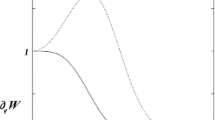Abstract
We consider the inversion problem for linear quantization defined by an integral transformation relating the matrix of a quantum operator to its classical symbol. For an arbitrary linear quantization, we construct evolution equations for the density matrix and the Wigner function. It is shown that the Weyl quantization is the only one for which the evolution equation of the Wigner function is free of a quasi-probability source, which distinguishes this quantization as the only physically adequate one in the class under consideration. As an example, we give an exact stationary solution for the Wigner function of a harmonic oscillator with an arbitrary linear quantization, and construct a sequence of quantizations that approximate the Weyl quantization and tend to it in the weak sense so that the Wigner function remains positive definite.
Similar content being viewed by others
References
M. Abramowitz and I. A. Stegun, Handbook of Mathematical Functions with Formulas, Graphs, and Mathematical Tables (J. Wiley & Sons, New York, 1972).
F. A. Berezin, “Non-Wiener functional integrals,” Theor. Math. Phys. 6 (2), 141–155 (1971) [transl. from Teor. Mat. Fiz. 6 (2), 194–212 (1971)].
F. A. Berezin, “General concept of quantization,” Commun. Math. Phys. 40, 153–174 (1975).
N. N. Bogolubov and N. N. Bogolubov Jr., Introduction to Quantum Statistical Mechanics (Nauka, Moscow, 1984; World Scientific, Hackensack, NJ, 2010).
L. A. Borisov and Yu. N. Orlov, “Analyzing the dependence of finite-fold approximations of the harmonic oscillator equilibrium density matrix and of the Wigner function on the quantization prescription,” Theor. Math. Phys. 184 (1), 986–995 (2015) [transl. from Teor. Mat. Fiz. 184 (1), 106–116 (2015)].
L. A. Borisov and Yu. N. Orlov, “Generalized evolution equation of Wigner function for an arbitrary linear quantization,” Lobachevskii J. Math. 42 (1), 63–69 (2021).
M. Born and P. Jordan, “Zur Quantenmechanik,” Z. Phys. 34, 858–888 (1925).
W. B. Case, “Wigner functions and Weyl transforms for pedestrians,” Am. J. Phys. 76 (10), 937–946 (2008).
N. Costa Dias and J. N. Prata, “Deformation quantization and Wigner function,” Mod. Phys. Lett. A 20 (17–18), 1371–1385 (2015).
R. P. Gaĭda, “Quasirelativistic systems of interacting particles,” Sov. J. Part. Nucl. 13 (2), 179–205 (1982) [transl. from Phys. Elem. Chast. Atom. Yadra 13 (2), 427–493 (1982)].
S. Mancini, V. I. Man’ko, and P. Tombesi, “Different realizations of the tomographic principle in quantum state measurement,” J. Mod. Opt. 44 (11–12), 2281–2292 (1997).
S. Mancini, V. I. Man’ko, and P. Tombesi, “Classical-like description of quantum dynamics by means of symplectic tomography,” Found. Phys. 27 (6), 801–824 (1997).
J. E. Moyal, “Quantum mechanics as a statistical theory,” Proc. Cambridge Philos. Soc. 45, 99–124 (1949).
S. Nasiri and S. Bahrami, “Reality of the Wigner functions and quantization,” Res. Lett. Phys. 2009, 298790 (2009).
J. von Neumann, Mathematische Grundlagen der Quantenmechanik (J. Springer, Berlin, 1932).
Yu. N. Orlov, Basics of Quantizing Degenerate Dynamical Systems (Mosk. Fiz.-Tekh. Inst., Moscow, 2004) [in Russian].
Yu. N. Orlov and I. P. Pavlotsky, “Quantum BBGKY-hierarchies and Wigner’s equation in postgalilean approximation,” Physica A 158 (2), 607–618 (1989).
Yu. N. Orlov, V. Zh. Sakbaev, and O. G. Smolyanov, “Feynman formulas as a method of averaging random Hamiltonians,” Proc. Steklov Inst. Math. 285, 222–232 (2014) [transl. from Tr. Mat. Inst. Steklova 285, 232–243 (2014)].
I. P. Pavlotskii, Introduction to Weakly Relativistic Statistical Mechanics (Inst. Prikl. Mat. Akad. Nauk SSSR, Moscow, 1987) [in Russian].
H. Weyl, Gruppentheorie und Quantenmechanik (Hirzel, Leipzig, 1931).
E. Wigner, “On the quantum correction for thermodynamic equilibrium,” Phys. Rev. 40 (5), 749–759 (1932).
Author information
Authors and Affiliations
Corresponding author
Additional information
Translated from Trudy Matematicheskogo Instituta imeni V.A. Steklova, 2021, Vol. 313, pp. 23–32 https://doi.org/10.4213/tm4195.
Rights and permissions
About this article
Cite this article
Borisov, L.A., Orlov, Y.N. On the Inversion Formula of Linear Quantization and the Evolution Equation for the Wigner Function. Proc. Steklov Inst. Math. 313, 17–26 (2021). https://doi.org/10.1134/S0081543821020036
Received:
Revised:
Accepted:
Published:
Issue Date:
DOI: https://doi.org/10.1134/S0081543821020036




